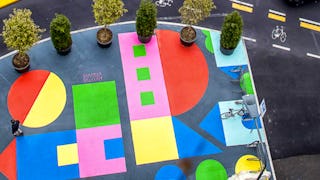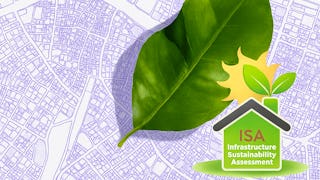This course will evaluate best practices in transportation networks, thoroughfares, and streetscape designs for the effective movement of people, goods, and services in a region. Sustainable public and private streetscape design and application will be reviewed and evaluated for applications for sustainable cities. Considerations are assessed for smart urban planning, growth, and lifestyle. Strategies for creating equitable, healthy, and sustainable communities are also evaluated.

3 days left: Get a Black Friday boost with $160 off 10,000+ programs. Save now.


Sustainable Transportation Networks and Streetscapes
This course is part of Sustainable Cities Specialization

Instructor: William Roper
4,625 already enrolled
Included with
(78 reviews)
Skills you'll gain
Details to know

Add to your LinkedIn profile
2 assignments
See how employees at top companies are mastering in-demand skills

Build your subject-matter expertise
- Learn new concepts from industry experts
- Gain a foundational understanding of a subject or tool
- Develop job-relevant skills with hands-on projects
- Earn a shareable career certificate

There are 3 modules in this course
The importance of sustainable city thoroughfares designed to interconnect into a hierarchical network is introduced. The largest thoroughfares allow for direct connection to the urban center. Analysis of smart urban planning growth and lifestyles is also discussed.
What's included
7 videos2 readings1 assignment1 discussion prompt1 plugin
Neighborhoods typically have a range of thoroughfare types to facilitate the movement of people through the neighborhood. Sustainable smart growth neighborhoods are designed to equitably allow pedestrians, bicycles, and the automobiles to move within the community. This module will evaluate a variety of techniques and policies that encourage this balanced multimodal use of transportation thoroughfares.
What's included
6 videos1 reading
Sustainable public streetscapes are much more than just a part of the infrastructure to facilitate the movement of automobiles. In addition to the vehicular lanes, they must include sidewalks, trees, curbs, lighting, and other elements that collectively constitute a sustainable public streetscape. Public streetscapes require careful design attention to contribute to a successful neighborhood. This requires a full range of regional appropriateness that corresponds to the transect. Private streetscapes are an extension of the public streetscape but relate specifically to the private sector building configuration and frontage design. Successful private sector streetscapes can include properly sized porches students, terraces, balconies, that enhance activity to the street.
What's included
6 videos1 assignment
Earn a career certificate
Add this credential to your LinkedIn profile, resume, or CV. Share it on social media and in your performance review.
Instructor

Offered by
Explore more from Environmental Science and Sustainability
 Status: Free Trial
Status: Free TrialJohns Hopkins University
 Status: Free Trial
Status: Free TrialJohns Hopkins University
 Status: Preview
Status: PreviewTechnical University of Munich (TUM)
 Status: Preview
Status: PreviewUniversitat Politècnica de València
Why people choose Coursera for their career




Learner reviews
78 reviews
- 5 stars
82.05%
- 4 stars
12.82%
- 3 stars
2.56%
- 2 stars
2.56%
- 1 star
0%
Showing 3 of 78
Reviewed on Jun 9, 2023
Lot of finer details for street and sidewalk considerations and standards.

Open new doors with Coursera Plus
Unlimited access to 10,000+ world-class courses, hands-on projects, and job-ready certificate programs - all included in your subscription
Advance your career with an online degree
Earn a degree from world-class universities - 100% online
Join over 3,400 global companies that choose Coursera for Business
Upskill your employees to excel in the digital economy
Frequently asked questions
To access the course materials, assignments and to earn a Certificate, you will need to purchase the Certificate experience when you enroll in a course. You can try a Free Trial instead, or apply for Financial Aid. The course may offer 'Full Course, No Certificate' instead. This option lets you see all course materials, submit required assessments, and get a final grade. This also means that you will not be able to purchase a Certificate experience.
When you enroll in the course, you get access to all of the courses in the Specialization, and you earn a certificate when you complete the work. Your electronic Certificate will be added to your Accomplishments page - from there, you can print your Certificate or add it to your LinkedIn profile.
Yes. In select learning programs, you can apply for financial aid or a scholarship if you can’t afford the enrollment fee. If fin aid or scholarship is available for your learning program selection, you’ll find a link to apply on the description page.
More questions
Financial aid available,

